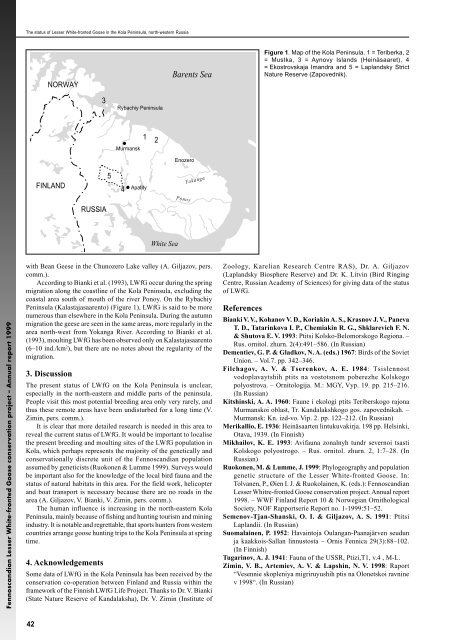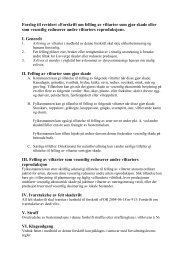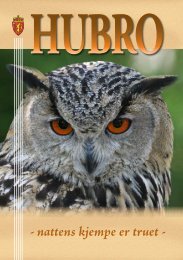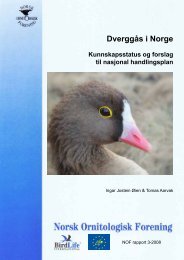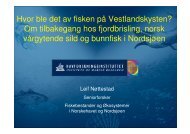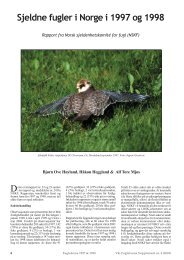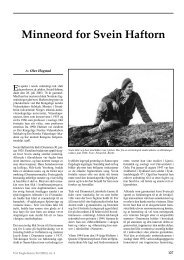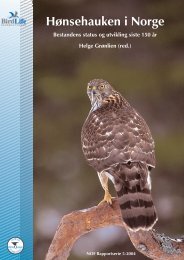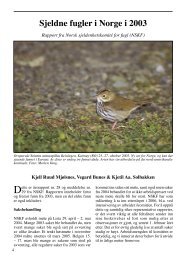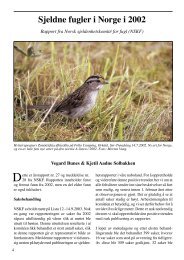Fennoscandian Lesser White-fronted Goose conservation project ...
Fennoscandian Lesser White-fronted Goose conservation project ...
Fennoscandian Lesser White-fronted Goose conservation project ...
You also want an ePaper? Increase the reach of your titles
YUMPU automatically turns print PDFs into web optimized ePapers that Google loves.
<strong>Fennoscandian</strong> <strong>Lesser</strong> <strong>White</strong>-<strong>fronted</strong> <strong>Goose</strong> <strong>conservation</strong> <strong>project</strong> – Annual report 1999<br />
The status of <strong>Lesser</strong> <strong>White</strong>-<strong>fronted</strong> <strong>Goose</strong> in the Kola Peninsula, north-western Russia<br />
42<br />
NORWAY<br />
FINLAND<br />
3<br />
RUSSIA<br />
5<br />
Rybachiy Peninsula<br />
Murmansk<br />
4<br />
Apatity<br />
1 2<br />
<strong>White</strong> Sea<br />
Barents Sea<br />
Enozero<br />
P o no y<br />
Yo kang a<br />
with Bean Geese in the Chunozero Lake valley (A. Giljazov, pers.<br />
comm.).<br />
According to Bianki et al. (1993), LWfG occur during the spring<br />
migration along the coastline of the Kola Peninsula, excluding the<br />
coastal area south of mouth of the river Ponoy. On the Rybachiy<br />
Peninsula (Kalastajasaarento) (Figure 1), LWfG is said to be more<br />
numerous than elsewhere in the Kola Peninsula. During the autumn<br />
migration the geese are seen in the same areas, more regularly in the<br />
area north-west from Yokanga River. According to Bianki et al.<br />
(1993), moulting LWfG has been observed only on Kalastajasaarento<br />
(6–10 ind./km 2 ), but there are no notes about the regularity of the<br />
migration.<br />
3. Discussion<br />
The present status of LWfG on the Kola Peninsula is unclear,<br />
especially in the north-eastern and middle parts of the peninsula.<br />
People visit this most potential breeding area only very rarely, and<br />
thus these remote areas have been undisturbed for a long time (V.<br />
Zimin, pers. comm.).<br />
It is clear that more detailed research is needed in this area to<br />
reveal the current status of LWfG. It would be important to localise<br />
the present breeding and moulting sites of the LWfG population in<br />
Kola, which perhaps represents the majority of the genetically and<br />
<strong>conservation</strong>ally discrete unit of the <strong>Fennoscandian</strong> population<br />
assumed by geneticists (Ruokonen & Lumme 1999). Surveys would<br />
be important also for the knowledge of the local bird fauna and the<br />
status of natural habitats in this area. For the field work, helicopter<br />
and boat transport is necessary because there are no roads in the<br />
area (A. Giljazov, V. Bianki, V. Zimin, pers. comm.).<br />
The human influence is increasing in the north-eastern Kola<br />
Peninsula, mainly because of fishing and hunting tourism and mining<br />
industry. It is notable and regrettable, that sports hunters from western<br />
countries arrange goose hunting trips to the Kola Peninsula at spring<br />
time.<br />
4. Acknowledgements<br />
Some data of LWfG in the Kola Peninsula has been received by the<br />
<strong>conservation</strong> co-operation between Finland and Russia within the<br />
framework of the Finnish LWfG Life Project. Thanks to Dr. V. Bianki<br />
(State Nature Reserve of Kandalaksha), Dr. V. Zimin (Institute of<br />
Figure 1. Map of the Kola Peninsula. 1 = Teriberka, 2<br />
= Mustka, 3 = Aynovy Islands (Heinäsaaret), 4<br />
= Ekostrovskaja Imandra and 5 = Laplandsky Strict<br />
Nature Reserve (Zapovednik).<br />
Zoology, Karelian Research Centre RAS), Dr. A. Giljazov<br />
(Laplandsky Biosphere Reserve) and Dr. K. Litvin (Bird Ringing<br />
Centre, Russian Academy of Sciences) for giving data of the status<br />
of LWfG.<br />
References<br />
Bianki V. V., Kohanov V. D., Koriakin A. S., Krasnov J. V., Paneva<br />
T. D., Tatarinkova I. P., Chemiakin R. G., Shklarevich F. N.<br />
& Shutova E. V. 1993: Ptitsi Kolsko-Belomorskogo Regiona. –<br />
Rus. ornitol. zhurn. 2(4):491–586. (In Russian)<br />
Dementiev, G. P. & Gladkov, N. A. (eds.) 1967: Birds of the Soviet<br />
Union. – Vol.7. pp. 342–346.<br />
Filchagov, A. V. & Tserenkov, A. E. 1984: Tsislennost<br />
vodoplavaytshih ptits na vostotsnom poberezhe Kolskogo<br />
polyostrova. – Ornitologija. M.: MGY, Vyp. 19. pp. 215–216.<br />
(In Russian)<br />
Kitshinski, A. A. 1960: Faune i ekologi ptits Teriberskogo rajona<br />
Murmanskoi oblast, Tr. Kandalakshkogo gos. zapovednikah. –<br />
Murmansk: Kn. izd-vo. Vip. 2. pp. 122–212. (In Russian)<br />
Merikallio, E. 1936: Heinäsaarten lintukuvakirja. 198 pp. Helsinki,<br />
Otava, 1939. (In Finnish)<br />
Mikhailov, K. E. 1993: Avifauna zonalnyh tundr severnoi tsasti<br />
Kolskogo polyostrogo. – Rus. ornitol. zhurn. 2, 1:7–28. (In<br />
Russian)<br />
Ruokonen, M. & Lumme, J. 1999: Phylogeography and population<br />
genetic structure of the <strong>Lesser</strong> <strong>White</strong>-<strong>fronted</strong> <strong>Goose</strong>. In:<br />
Tolvanen, P., Øien I. J. & Ruokolainen, K. (eds.): <strong>Fennoscandian</strong><br />
<strong>Lesser</strong> Whitre-<strong>fronted</strong> <strong>Goose</strong> <strong>conservation</strong> <strong>project</strong>. Annual report<br />
1998. – WWF Finland Report 10 & Norwegian Ornithological<br />
Society, NOF Rapportserie Report no. 1-1999:51–52.<br />
Semenov-Tjan-Shanski, O. I. & Giljazov, A. S. 1991: Ptitsi<br />
Laplandii. (In Russian)<br />
Suomalainen, P. 1952: Havaintoja Oulangan-Paanajärven seudun<br />
ja kaakkois-Sallan linnustosta – Ornis Fennica 29(3):88–102.<br />
(In Finnish)<br />
Tugarinov, A. J. 1941: Fauna of the USSR, Ptizi,T1, v.4 , M-L.<br />
Zimin, V. B., Artemiev, A. V. & Lapshin, N. V. 1998: Raport<br />
“Vesennie skopleniya migriruyushih ptis na Olonetskoi ravnine<br />
v 1998“. (In Russian)


